ANSYS BLOG
September 2, 2022
Nature Architects Reshapes a Cleaner Future with Simulation, Geometry, and Metamaterials
Even designers with limitless imaginations are often restricted by which materials are available to them and how those materials will function. But what if you could design the material functionality you needed? Nature Architects provides shape design solutions for manufacturers to incorporate various physical functions such as vibration, acoustics, heat conduction, deformation, and weight reduction into their products by using metamaterials.
"Metamaterials" is a generic term for structures that realize functions beyond the physical functions of materials — such as resins and metals — through artificially designed geometric structures. The use of metamaterials will make it possible to achieve advanced physics properties that were previously thought impossible with conventional materials and components.
Metamaterials also include structures that generate mechanical movement through elastic deformation, such as moving parts referred to as compliant mechanisms. In addition, metamaterials can be used to create advanced physics properties in a single structure without assembly, which has conventionally been achieved by assembling mechanical parts or combining different materials. Typically, these are made by additive manufacturing, but in some cases, conventional manufacturing methods such as injection molding, press molding, and machining can be used.
In this way, metamaterials can be used to incorporate new physics properties into products without increasing the number of assembled parts. Metamaterials enable designers and engineers to go beyond conventional methods by balancing multiple trade-offs in design requirements, such as light weight and high stiffness.
With support from the Ansys Startup Program, which encourages early-stage startups by offering affordable access to Ansys’ simulation solutions, Nature Architects is using simulation to advance this emerging technology and build more metamaterials and structural solutions that will reshape the future.
Simulating New Geometric Dimensions
Founded in 2017, Nature Architects set out to empower designers and engineers to design products capable of functions that defy the bounds of conventional materials and components.
To appreciate the unique capabilities of metamaterials, you must first recognize the constraints of nature and physics. A basic example of this can be demonstrated with any stretchy material such as rubber or spandex. When you pull on both ends of a rubber band, it becomes narrower and longer. In mechanical engineering, this concept is the basis of the Poisson effect — the deformation of a material perpendicular to the point of force or direction of loading — or, in this example, the direction that the hand pulls the rubber band. For the rubber band, Poisson’s ratio is the relationship of the width as the band narrows and contracts to its extended length toward the pulling direction. By knowing Poisson’s ratio for a material, you can predict its reaction to stresses in a repeatable manner.
However, by creating metamaterials with a negative Poisson’s ratio, it is possible to generate new properties that enable the material to react differently than expected, or what is even considered possible. For a rubber band, this could result in widening of the band upon pulling its ends, instead of narrowing. Materials constructed with a negative Poisson’s ratio are also known as auxetic materials.
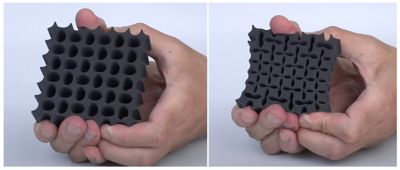
The simple geometry of elastomers with holes realizes controlled buckling deformation and efficient conformity to the human body.
Integrating this concept to construct mechanical metamaterials, Nature Architects developed their signature Direct Functional Modeling (DFM) technology to create structures that go beyond what regular materials can achieve.
For example, Nature Architects can design material substitution from rubber to plastic by utilizing metamaterials. Specifically, the cushioning portion of an office chair is made of an integrated plastic honeycomb structure to achieve flexibility that disperses body pressure efficiently. Appropriate substitution of materials can create added value, such as lower cost, improved design through better moldability, improved recyclability, and lighter weight.
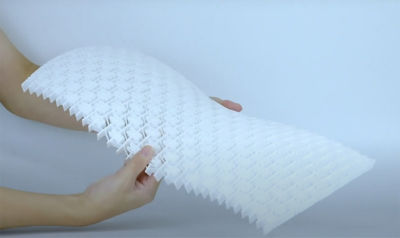
The perforated structure of the engineering plastic plate follows the human body and deforms in such a way as to disperse pressure efficiently. It is made up of diagonal beams that include a re-entrant honeycomb structure and boxes that are properly aligned to achieve a double-curved surface.
In addition to enhancing creative possibilities, metamaterials have the potential to contribute to sustainability because they can add functionality without increasing material usage.
“By combining structures that express innovative functions, such as metamaterials, with inverse calculation techniques, we are able to achieve a high level of function-to-shape,” says Taisuke Ohshima, CEO at Nature Architects, describing the company’s DFM technology. “The Ansys Startup Program has allowed us to use advanced simulations that would have been cost-prohibitive to implement at the startup stage of the company and has helped us automate and advance our analysis and design systems, expanding the range of industries and problems we can handle as a company.”
Ohshima and fellow engineers have integrated simulation to conquer what they say is a top challenge in geometric design: the automation of new structure discovery. Using Ansys Mechanical for structural analyses and fluid-structure interaction, the team implements Mechanical Ansys Parametric Design Language (MAPDL), a scripting language that automates simulation tasks and streamlines workflows. This automation allows the team to visualize and explore countless new structures. Engineers can also use MAPDL to build models with new variables and parameters through features including design optimization and adaptive meshing.
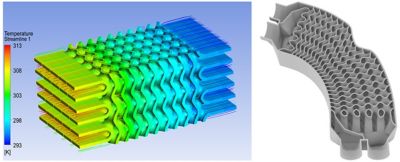
Nature Architects uses Ansys Fluent to analyze two-fluid heat exchange performance in lattice structures.
“Automation of simulations and advancement in dealing with nonlinear problems are helping us to develop systems to overcome this challenge,” says Ohshima. “We have a customized and automated system for DFM using Mechanical APDL, from geometry definition to analysis and post-processing, benefiting from a wide variety of constraints and elements.”
Additionally, the group uses Ansys Fluent to analyze two-fluid heat exchange performance in lattice structures, which enables them to design heat exchangers.
Nature Architects’ signature Direct Functional Modeling technology reinvents material properties using geometric structures to produce desired movement without typical external components, as demonstrated in this video with universal flex joints that were created without springs or conventional assembly.
Solutions in Action
DFM technology boosts the capabilities of traditional functional modeling by generating the appropriate metamaterial structure instantly based on its desired physical function. With DFM, Nature Architects can add various physical functions into products that were unattainable before, including flexibility, deformation, thermal conductivity, and vibration absorption. DFM technology is used most effectively for products that deal with motion, such as automotive, aerospace, and robotics, as well as components such as fans, springs, switches, and levers. By reimagining these compliant mechanisms, Nature Architect engineers produce the desired movement through integrated structures, reducing the need for external operating parts and components, including hinges, screws, and bolts.
If the movable parts can be made as a single piece using a compliant mechanism, it is possible to eliminate the need for multiple parts, and therefore, assembly. In addition, if a compliant mechanism is properly designed with DFM, it is possible to integrate those functions into the piece, creating the same functionality in a single unit.
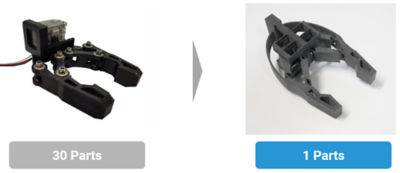
The movement of a robot hand, which typically requires at least 30 parts, including hinges and other rigid mechanisms, can be reproduced using Direct Functional Modeling and a single compliant mechanism that requires no assembly.
With a team of 15, Nature Architects does not directly produce end products, but supplies metamaterials and DFM solutions to manufacturers, often collaborating in development and supporting product design. Essentially, Nature Architects builds and operates software modules equipped with DFM technology to automate the design process for each customer and project.
Currently, Nature Architects provides three solutions using DFM technology — DFM PULSE, DFM TOUCH, and DFM UNWELD — which enhance capabilities in vibration, haptics, and sheet metal processing, respectively. Applications of the solutions range from automobiles to music equipment.
An automotive component company currently uses DFM PULSE to isolate vibration in components around sensors and is working with a leading air conditioning (AC) manufacturer to develop vibration isolation components for AC systems. A construction company integrates DFM UNWELD technology to manufacture building components, and DFM TOUCH is being used to develop equipment for the entertainment industry.
Metamaterials are key building blocks to DFM solutions and offer a range of properties depending on the needs of the company or application. For example, the triangular prism-based auxetic lattice structures used for the cushion padding mentioned above possess unprecedented rigidity control that provides stress relief for automotive sensor peripheral components and can also be implemented to reduce vibration. Traditionally, vibration isolation techniques require elasticity from external components such as rubber or springs, but DFM technology recreates these compliant mechanisms in other materials. For instance, DFM PULSE can be used to fabricate elastic properties with metamaterials to alter any composite or material, including glass, plastic, wood, or metal.
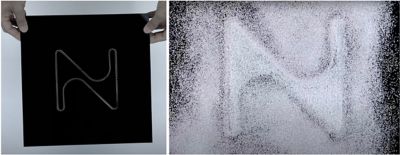
A perforated sheet of plastic works as vibration isolation. In this demonstration, Nature Architects has isolated their “N” logo from the vibration source.
In addition to space-filling structures like the octet truss, metamaterials can enhance physical properties in two-dimensional structures as well. This means that geometric design and metamaterials not only benefit AM and 3D printing projects, but can also aid in conventional manufacturing methods, including injection molding and pressing.
Designing for Tomorrow
Nature Architects is already catching the attention of manufacturing companies. Last summer the startup was awarded a grant from Japan’s New Energy and Industrial Technology Development Organization, a national research and development agency with global offices that promotes the development and introduction of new energy technologies that support sustainability.
This spring, the Nature Architects team received the EXPO Startup Award through an accelerator program of Plug and Play Japan. Plug and Play is a corporate innovation platform headquartered in Silicon Valley, California, with offices around the world that support startups through accelerator programs, investment, and networking. Plug and Play has worked with some of the most successful startups in history, including Google, Dropbox, and PayPal.
“By innovating designs based on the use of conventional manufacturing methods, we can improve the efficiency of product design and add value to products,” says Ohshima. “Ansys’ simulation is beneficial for the automation and advancement of analysis in our proprietary design system.”
To learn more about Nature Architects visit their website or YouTube channel. For more information about the Ansys Startup Program, browse product packages and eligibility here.










